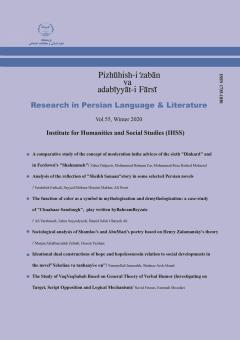-
-
List of Articles
-
Open Access Article
1 - A comparative study of the concept of moderation inthe advices of the sixth "Dinkard" and in Ferdowsi's "Shahnameh
zahra delpazi Mohammad behnamfar MOHAMMAD REZA RASHED MOHASSEL -
Open Access Article
2 - Analysis of the reflection of "Sheikh Sanaan"story in some selected Persian novels
sudabe farhadi mohsen hoseyni ali noori -
Open Access Article
3 - The function of color as a symbol in mythologization and demythologization: a case-study of "Chaahaar Sandough", play written byBahramBeyzaie
ali yarahmadi زهرا سیدیزدی hamid jafari gharyeh ali -
Open Access Article
4 - Sociological analysis of Shamloo's and AbuMazi's poetry based on Henry Zalamansky's theory
marjan aliakbarzade zehtab Hossen Yazdani -
Open Access Article
5 - Ideational dual constructions of hope and hopelessnessin relation to social developments in the novel"Yekoliaa va tanhaayi-e ou"
nematollah hiranzade Shahnaz Arsh Akmal -
Open Access Article
6 - The Study of VaqVaqSahab Based on General Theory of Verbal Humor (Investigating on Target, Script Opposition and Logical Mechanism)
Navid Firuzi Fatemeh Mozaffari
-
The rights to this website are owned by the Raimag Press Management System.
Copyright © 2017-2025







